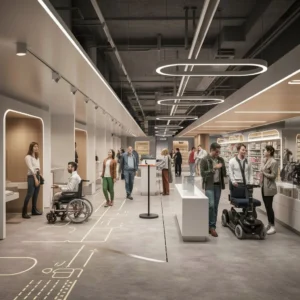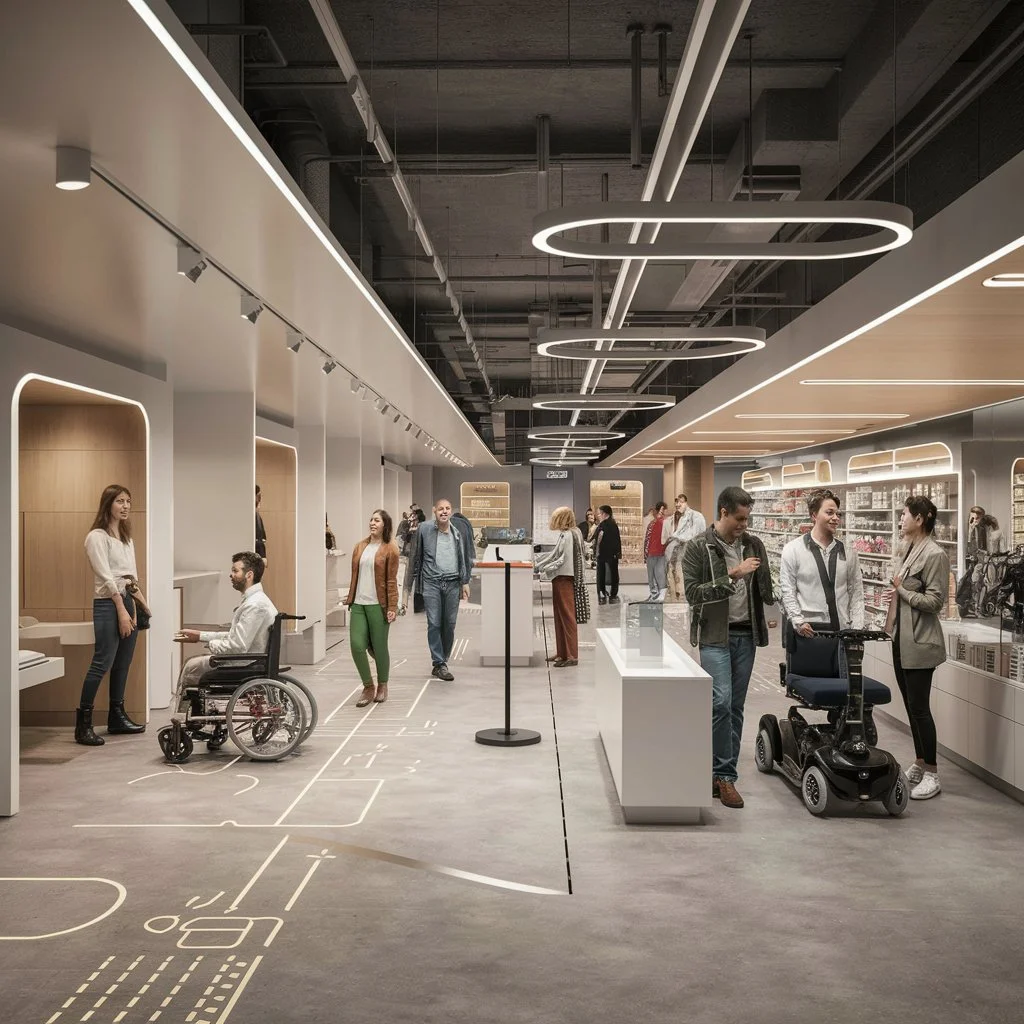Improving Accessibility in Retail Environments
Imagine entering a store where every aisle is designed to meet your needs, every product is simple to locate, and everyone is made to feel welcome, regardless of ability or mobility issues. Accessibility is no longer merely a consideration when a retail revolution is about to happen; rather, it is now essential to a positive shopping experience. This blog article will discuss how inclusive practices, state-of-the-art design, and cutting-edge technology are making retail settings welcoming to all customers. Come explore the fascinating developments influencing accessible shopping in the future, whether you’re a retailer seeking to improve your clientele’s experience or a business owner hoping to provide more inclusive alternatives!
Overview of the subject of accessibility in retail settings
Although it’s an essential part of life, shopping can be intimidating for some people. In retail settings, accessibility is frequently disregarded, which makes a great number of people feel excluded. Imagine entering a store and being confronted right away by barriers that prevent you from perusing or buying anything. Millions are impacted by this reality, including parents using strollers, the elderly, and people with disabilities.
Accessibility isn’t simply about compliance; it’s about establishing settings where everyone feels welcome. As we delve deeper into this topic, we’ll investigate how shops may raise accessibility in both physical and digital venues. Being more inclusive is not just in style; it’s necessary to build bridges between companies and all of their clients. Come along as we unearth cutting-edge ideas meant to improve everyone’s shopping experience!
Definition of accessibility and its importance
Accessibility refers to the design of products, technologies, services, or surroundings for people with impairments. It involves a wide range of factors, from physical access in retail places to digital usability online.
It is impossible to exaggerate the significance of accessibility. Equal possibilities are created for everyone when shopping spaces are accessible. This inclusiveness improves the reputation of the brand and encourages consumer loyalty.
Adopting accessibility also shows a commitment to social responsibility rather than just following the law. By reaching a wider audience, retailers who put these principles first frequently experience increases in foot traffic and sales.
In the end, improving accessibility empowers everyone while improving the purchasing experience. Retailers set the stage for a more inclusive economy by making sure that everyone can easily navigate both physical and virtual areas.
The accessibility of shopping at the moment
In retail, accessibility is a critical issue. Many retailers still find it difficult to satisfy every customer’s needs. While some have advanced, others have not kept up.
Physical obstacles are still frequently encountered. Heavy doors and narrow aisles might be problematic for people with mobility issues. Furthermore, braille or obvious visual cues for customers with visual impairments are frequently absent from signage.
Online platforms come with their own unique set of challenges. Websites could not provide alternative text for photos or be poorly suited for screen readers. Many people are unable to navigate properly as a result of this error.
Retailers are becoming more conscious of the need for inclusivity, though. A growing number of brands are starting to implement strategies that improve accessibility in retail settings. The change towards greater comprehension is a reflection of shifting social norms and customer expectations regarding disability rights.
Technology’s effect on improving accessibility in retail

Accessibility in retail is being revolutionised by technology. Everybody can now enjoy more inclusive shopping experiences thanks to innovations.
By removing physical constraints, virtual reality (VR) enables customers to experience stores from the comfort of their homes. People with mobility problems can browse products at their own pace with this interactive experience.
Customers may easily navigate aisles with the help of smart shopping carts that include navigation features. These sophisticated tools can customise the experience to meet individual needs by making item suggestions based on dietary restrictions or preferences.
Furthermore, voice commands and customisable interfaces that accommodate a range of disabilities are now available in mobile apps. All clients will feel empowered during their shopping experience thanks to this technology.
Retailers gain from these innovations as well because they draw in more customers and increase audience reach. Accessibility is an opportunity for growth and innovation in the retail industry, not just for compliance’s sake.
The way we shop is changing thanks to virtual reality (VR). Retailers are adopting VR to build immersive experiences where customers can examine things from the comfort of their homes. This technology allows those with mobility problems to enjoy shopping as if they were physically present in-store.
Smart shopping carts are another innovation making waves in accessibility. Equipped with sensors and navigation systems, these carts help shoppers find their items quickly. They can even provide assistance for those who might struggle with heavy lifting or navigating crowded aisles.
Benefits for both customers and businesses
Improving accessibility in retail not only benefits consumers but also transforms the industry for companies. Shops that are dedicated to improving accessibility throw open their doors, both literally and metaphorically.
Clients with impairments experience a sense of worth and welcome. This promotes repeat business and loyalty. Everyone can browse comfortably in an inclusive store, which increases the number of sales opportunities.
For retailers, accessible spaces often translate into higher customer satisfaction rates. Happy shoppers tend to spend more time in-store, which boosts overall revenue.
Moreover, embracing accessibility can strengthen a brand’s reputation as socially responsible. Consumers of today value businesses that put an emphasis on community involvement and inclusivity.
By simplifying procedures, investing in accessible technology can also lower operating costs. Ingenious solutions enhance the shopping experience while streamlining inventory management.
To put it briefly, fostering an inclusive environment is wise business strategy as well as good practice.
Designing inclusive spaces: Best practices for retailers
Creating an inclusive retail environment starts with understanding the diverse needs of customers. Universal design principles should guide every decision, ensuring that spaces cater to all abilities.
Wide aisles are essential for easy navigation. They allow individuals using wheelchairs or mobility devices to move freely without obstacles.
Incorporating braille signage is another best practice. This small addition can make a significant difference for visually impaired shoppers, providing them with vital information about products and store layout.
Consider adjustable check-out counters to accommodate various heights and disabilities. Such thoughtful designs promote inclusivity and enhance the overall shopping experience.
Lighting also plays a critical role. A well-lit room decreases anxiety and helps everyone travel comfortably, making it easier for people with visual impairments or cognitive issues.
Lastly, incorporate persons with impairments in the planning process. Their thoughts are crucial in designing truly accessible settings where everyone feels welcome.
Importance of universal design principles
Universal design concepts are vital in building settings that appeal to everyone, regardless of their ability. These guidelines emphasise usefulness and inclusivity for all people.
Businesses create a welcoming environment for all customers by incorporating universal design into their retail spaces. This strategy improves everyone’s shopping experience rather than just following the rules.
Take into account components like design and signage. Customers can find what they need without needless frustration thanks to intuitive navigation.
Additionally, by emphasising accessible design, businesses not only draw in a larger clientele but also foster brand loyalty from patrons who value careful attention to detail in the service area.
Creating a more accessible physical environment starts with thoughtful design. In order to accommodate wheelchairs and other mobility devices, wide aisles are necessary. This simple change can make a significant difference in navigating retail spaces.
Consider the placement of products as well. Ensure that frequently purchased items are within reach for everyone, including those who may not be able to bend down easily.
Braille signage is another vital element. It empowers visually impaired individuals by providing them with clear information about their surroundings. Signs should be carefully placed at eye level or just above it.
Incorporating seating places throughout your store also promotes accessibility. These areas allow shoppers to take pauses, making the shopping experience less taxing and more enjoyable for all customers.
Finally, think about lighting—a well-lit environment avoids shadows and makes everyone feel safe while wandering around the business.
Improving digital accessibility for online shopping
Online shopping has altered the way we connect with retail, yet accessibility concerns persist. Many individuals with disabilities find challenges when exploring websites and apps. These hurdles can dissuade potential shoppers and hinder their whole purchasing experience.
Businesses need to give screen reader compatibility top priority if they want to improve digital accessibility. This guarantees that consumers with vision impairments may quickly obtain product details and seamlessly finish transactions.
Adding keyboard navigation is an additional useful tactic. It makes it possible for people who are mouse-illiterate to navigate categories and checkout procedures with ease.
It is easier for everyone to understand product offerings when they are presented clearly and with alt text for photographs. This strategy not only supports persons with disabilities but also benefits all users by offering greater context.
Real user testing of your app or website on a regular basis can reveal hidden problems. Diverse audiences’ feedback motivates advancements in building an inclusive online shopping environment for all consumers.
The difficulties that people with disabilities encounter
Online shopping can provide special challenges for those with disabilities. Many websites are difficult to navigate because they lack features that cater to different demands.
Those who use screen readers may find it more annoying when websites are badly designed. Frequently, images lack alt text that describes them, so users are uninformed of what the images actually mean. This discrepancy restricts what you can buy.
Complicated forms and checkout procedures may present a lot of difficulties. Users can have trouble entering data quickly or run across payment choices that aren’t available.
The absence of transcripts or subtitles for video information also poses a hurdle. Due to this error, important product information is not accessible to people who are hard of hearing or deaf.
Access is further complicated by varying site design across platforms. Customers looking for inclusivity in their retail experiences may face an uneven playing field because of this. What functions well on one website might not translate well to another.

